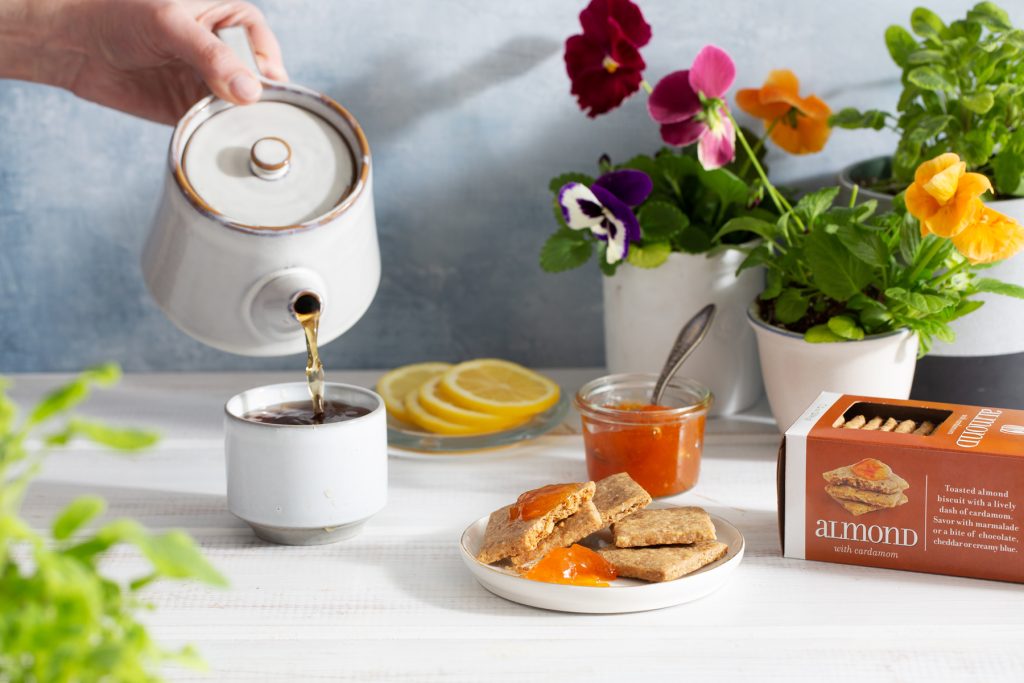The Deli Cracker Difference
December 1, 2021 | 7 min to read
Deli crackers, often appearing more homemade, have evolved alongside changing consumer habits, according to Cara Figgins of Partners, a Tasteful Choice Co. They are now perceived as higher quality, featuring artisan tastes and made from natural ingredients. Steve Lorenz from Dare Foods notes that these products, once found primarily in specialty stores, have gained prominence in conventional supermarkets due to increasing consumer demand for healthier snacking options and prepared meals.

Crackers found in the deli sections of supermarkets tend to differ from their counterparts in grocery aisles in a variety of key ways, but Cara Figgins, president of Des Moines, WA-based Partners, a Tasteful Choice Co., which makes a variety of baked goods, says one simple eye test can help to identify deli crackers.
“If it looks homemade, it should go in the deli,” Figgins says.
The crackers in the deli section have evolved in recent years, and the ways that supermarkets feature them have evolved, too, changing to meet shifts in customers’ eating and shopping habits. For instance, Steve Lorenz, director of marketing for deli brands for Dare Foods, based in Cambridge, Canada, says Dare’s cracker products have always appeared in deli departments, but the company’s deli brands initially were established in the specialty/natural store channel.
“Those store types typically had a greater emphasis on the perimeter or specialty departments than conventional food retailers,” Lorenz says. “That, of course, has changed dramatically as the conventional food channel began emphasizing prepared meals and the healthier components that make up the perimeter of the store.”
Figgins says supermarket deli crackers should be of a higher quality to meet consumer expectations of fresh, artisan tastes and textures.
Joan MacIsaac, co-owner of Effie’s Homemade, based in Hyde Park, MA, says the crackers found in the deli cheese section of the supermarket typically are specialty products.
“Often, these crackers are small-batch made, use high-quality and natural ingredients and have unique flavor profiles,” MacIsaac says.
The move toward healthier eating and snacking among consumers, including a focus on non-GMO and organic products, means shoppers are spending more time and money in the perimeter of the grocery store, Lorenz says.
“This is further emphasized by the shift toward prepared meals and prepared ingredients that ease the task of cooking at home,” Lorenz says. “These same trends are what you see driving the growth in the number of meal kits currently on the market.”

Ingredients and Texture
Lorenz notes that many of the crackers in the deli space focus more on a “topped” eating occasion, while brands in the grocery aisle are more geared toward “untopped” snacking. For instance, Dare’s deli brands La Panzanella Croccantini and Lesley Stowe Raincoast Crisps are designed to elevate toppings, spreads or dips from the deli department, he says.
“A key to that success is making sure the cracker can hold up to a topping by maintaining a crisp, complementary texture while also utilizing subtle flavors that enhance the topping, creating just the right amount of added flavor complexity,” Lorenz says.
Figgins says some large current influences on the deli cracker market tap into larger trends, such as sustainability.
“There is more and more focus on unique ingredients as well as environmentally intentional products—upcycling and regenerative, purpose-driven items that resonate with consumers,” Figgins says. “Taste is still the driver, but these are trends.”
In recent years, Figgins says the crackers category is seeing “so many more ingredients to choose from. More focus on alternative ingredients like cassava, banana flour, oat, almond, cauliflower and all combinations.” Figgins says those changes have been driven by the emergence of gluten-free, Paleo and Keto diets, which “have created investigation and experimentation.”
Lorenz believes deli crackers need “to manage their subtleness,” meaning avoid getting too adventurous with flavors.
“That being said, I think we are seeing more of the flavors being influenced by healthier or alternative flours and ingredients,” Lorenz says. “We are seeing more shifting toward healthier ingredients, like our Sprouted Whole Grain Croccantini or our Wild Blueberry and Almond Raincoast Crisps with added super seeds like chia and pumpkin. Some of our competitors are also implementing flax components or chickpeas as a main ingredient.”
All of Venus Wafers’ products are organic and non-GMO, but Jim Anderko, vice president of sales and marketing for the Hingham, MA-based company, says there is room to explore a range of ingredients and styles to capture consumers’ interest and meet their evolving preferences within those types of limits.
“We’re always trying to come up with different styles or flavors or something unique that’s going to be a home run that no one else has,” he says.
Packaging Choices
MacIsaac says great packaging with clear text and simple messaging is crucial to successfully marketing specialty cracker products.
“Things like shelf talkers, discounts and passive sampling certainly help boost sales, but products need to stand out and talk for themselves every day of the year,” MacIsaac says. “We recently had a packaging change after we went through a branding exercise. It was so insightful to receive feedback directly from consumers and understand how they see our brand. Clean and bright packaging with targeted messaging is key.”
In particular, packaging using clear tubs or windows has become nearly standard. “Deli consumers want to see the crackers,” Figgins says.
Lorenz agrees, saying that a prevalent packaging trait he sees in the deli space more than in the grocery aisle is that “the shopper wants to ‘see’ the product.”
“Whether clear packaging or a window in the packaging, most deli brands allow the shopper to see the product they are getting,” Lorenz says.
Anderko says Venus Wafers has been experimenting with different packaging and presentations that allow shoppers to see inside the package and provide “a cleaner look,” using tools such as printed film and overwrap trays. Customers generally like to see products in the deli area and are accustomed to it, he says.
“Everything in the deli tends to be very visible,” Anderko says. “You see what you’re buying, whether it’s cheese or hummus or soup, so when you buy crackers you want it to be the same.”
In addition, resealable packaging is growing in popularity, Lorenz says. Deli crackers formerly were more focused on entertaining occasions, but in a trend that was accelerated by the pandemic “we have seen a shift to more and smaller occasions or healthier snacking,” Lorenz says.
“That means when someone is buying deli crackers, they may not use much of the package for each sitting, since they may just be having a healthier, light snack of cheese or charcuterie with crackers for their lunch,” Lorenz says. “This has driven some increased demand for resealable/recloseable packaging.”
Powerful pairings
In merchandising, MacIsaac says buyers in the deli cheese category seek premium crackers on their shelves to help attract consumers willing to pay a higher price for quality over quantity.
“This consumer would naturally also purchase the cheeses and accompaniments that are sold in the same section of the store,” MacIsaac says. “Over the years, we’ve seen many larger retailers trim the SKUs in the deli cheese section, reserving the space for products that turn and offer the retailer strong margins.”
Crucial to successfully marketing and merchandising crackers in the supermarket deli is making appropriate pairings clear, Figgins says.
“Put the right crackers with the cheese it most enhances, creating immediate one-stop solutions in the deli,” Figgins says. “Crackers and cheese/meat/spreads/olives all in one spot, making it easy for the consumers.”
Lorenz agrees, saying, “Because deli crackers are designed as carriers, the ideal placement is near the toppings they are to be paired with. This simplifies the shopping process for the consumer by enabling them to pair their items all in one location.”
Lorenz says finding good strategic brand partners for cross merchandising is critical to successfully marketing and merchandising crackers in the supermarket deli.
“We try to find great cheese and charcuterie partners as well as wine or beer brands that we can market as an ‘experience’ for the shopper,” Lorenz says. “By clearly communicating that all of these wonderful items work well together and you can impress your guests by sharing these great foods and beverages, we are not only helping the shopper solve a problem, we are increasing the average ring for the retailer.”
Another option is partnerships such as the ones that the La Panzanella brand of crackers has with some artisanal charcuterie brands. In those instances, the crackers are included in the charcuterie brands’ on-the-go snack packs as the preferred cracker, Lorenz says.
MacIsaac called the deli/cheese section of supermarket stores “a melting pot of specialty items that complement each other.” In the end, they work together.
“The consumer that is entertaining will head to this department and find the artisan cheeses, interesting cracker options and the perfect accompaniments to assemble a well-curated cheese board all in the same department,” MacIsaac says. “The consumer can do one-stop shopping in the deli with the assistance of knowledgeable staff guiding them. We often work with our retailers on specific pairing ideas in the form of ‘1-2-3’ pairing displays with great stylized photography and recipes. It’s an easy sell.” DB
7 of 8 article in DeliBusiness Dec/Jan 2021

